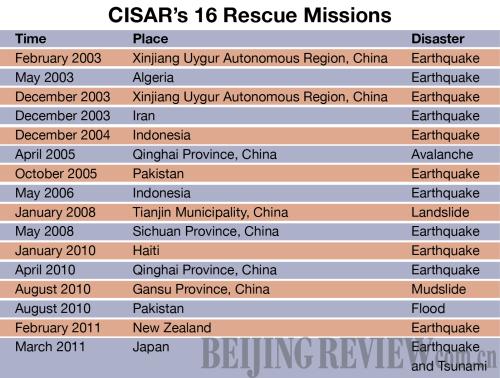|
At least twice a year, CISAR members, including military personnel, seismological experts and medical workers, gather at this "disaster scene" to receive training. During a two- to four-week training period, they take mandatory courses in a range of fields including medical treatment, demolition, forcing entry and communication.
"The training center's extremely realistic disaster scenes are created by controlled explosions and architects who design special wrecks," said Hu Jie, a senior trainer at the center.
Architects can simulate various collapsing and crushing scenarios for search and rescue training purposes, Hu said. Except for a few permanent structures representing partially collapsed buildings, many post-earthquake scenes have to be designed and built according to the needs of the training courses.
A four-story building leaning at a 19-degree angle is especially eye-catching. Hu said earthquakes often tilt buildings to similar angles.
A lopsided building can make it difficult for rescuers to maintain their balance. "In 1999, after a 7.3-magnitude earthquake in Taiwan, some inexperienced rescuers fell from leaning buildings," Lu said.
The leaning building was erected to familiarize rescuers with this sort of situation. Team members used the structure to learn how to prop up or break walls and floor slabs, and transport survivors on stretchers.
To create the earthquake scenes used for training, excavators and other heavy equipment are used to move concrete slabs and rubble around. Dummies are buried in various locations for CISAR members to find and extract.
By learning how to build and dismantle ruins, rescuers practice how to save lives, said Jia Qunlin, an official with the National Earthquake Response Support Service. Trainees must go through tests in various simulated scenarios and only those passing the test can qualify for rescue missions.
In addition to its simulated disaster zone, the training base has other state-of-the-art facilities including a 17,000-square-meter teaching complex and a 4D theater. In the theater one can have a realistic experience of an earthquake: explosions and raging fires caused by gas leakage.
Pointing at the characters carved on a large stone placed in front of the training center's gate, Hu said the CISAR's motto is "Virtue, Wisdom and Valor." That is to say team members should be compassionate, brave and smart at the same time, he said.
On November 12-14, 2009, CISAR members took a 36-hour exam at their training base. In the face of strong winds, heavy snow and the freezing cold, the examinees were required to dig earthquake "survivors" out from under tons of rubble.
The exam was administered by the International Search and Rescue Advisory Group (INSARAG) under the UN. The examiners were the eight members of the INSARAG expert panel and 20 plus rescue experts from several countries. The test covered a wide range of subjects. Examinees were tested on their preparedness, mobilization, operation and demobilization capacities.
This was part of the INSARAG External Classification (IEC) process, which evaluates search and rescue teams in management, logistics, search, rescue and medical capabilities. The IEC process classifies teams into light, medium and heavy teams.
The highest qualification for a search and rescue team under the UN system is heavy team. According to INSARAG Guidelines, heavy teams can carry out complex technical search and rescue missions in collapsed or compromised structures.
Heavy teams must be able to arrive at disaster-stricken areas within 48 hours, and must be able to operate around the clock for several days at two independent sites. They should be able to communicate well and work closely with the UN and the government of the disaster-stricken country.
A heavy team must meet top international standards in terms of response, search and rescue capability, equipment, hours of continuous operation and on-site coordination ability.
After 26 hours of grueling examination, CISAR members passed the test. The CISAR became one of only 12 heavy teams in the world, the second one in Asia and the only one from a developing country.
The IEC exercise that the CISAR went through was one of the most testing ones in recent years, said Toni Frisch, INSARAG's Chairman, who witnessed the testing process. Frisch said he looked forward to CISAR playing a greater role in international search and rescue operations.
Chen Jianmin, Director of the China Earthquake Administration, said the IEC would make Chinese rescue teams more professional.
An open team
Although only 10 years old, CISAR has grown up fast, partly due to its opening-up policy.
"As soon as the equipment was in place, we began to invite domestic and foreign experts to deliver training and we also send team members to receive training abroad," Yin said.
Since 2002, Swiss experts have been training Chinese CISAR members with the aim of building up top-level search and rescue teams that can be deployed anywhere in the world. Shortly after the CISAR was set up, Beat Kunzi, who was responsible for the Prevention and Preparedness at the Swiss Humanitarian Aid Unit, came to Beijing to offer help. For his commitment, he was granted the 2009 Chinese Government Friendship Award, the highest honor for a foreign expert working in China.
The CISAR also sends members to receive training abroad. For instance, in December 2006, CISAR sent members to Singapore to receive training, along side of 200 or so rescuers from 37 other countries. Twelve CISAR members, led by Liu Xiangyang, the CISAR's deputy head, got excellent scores in the training. Liu stood out among trainees with straight A's in five courses.
The CISAR has signed agreements on joint training with several countries. Members returning from overseas training trips have spread their skills and spurred the whole team to grow.

| 